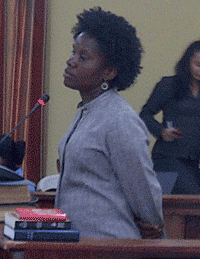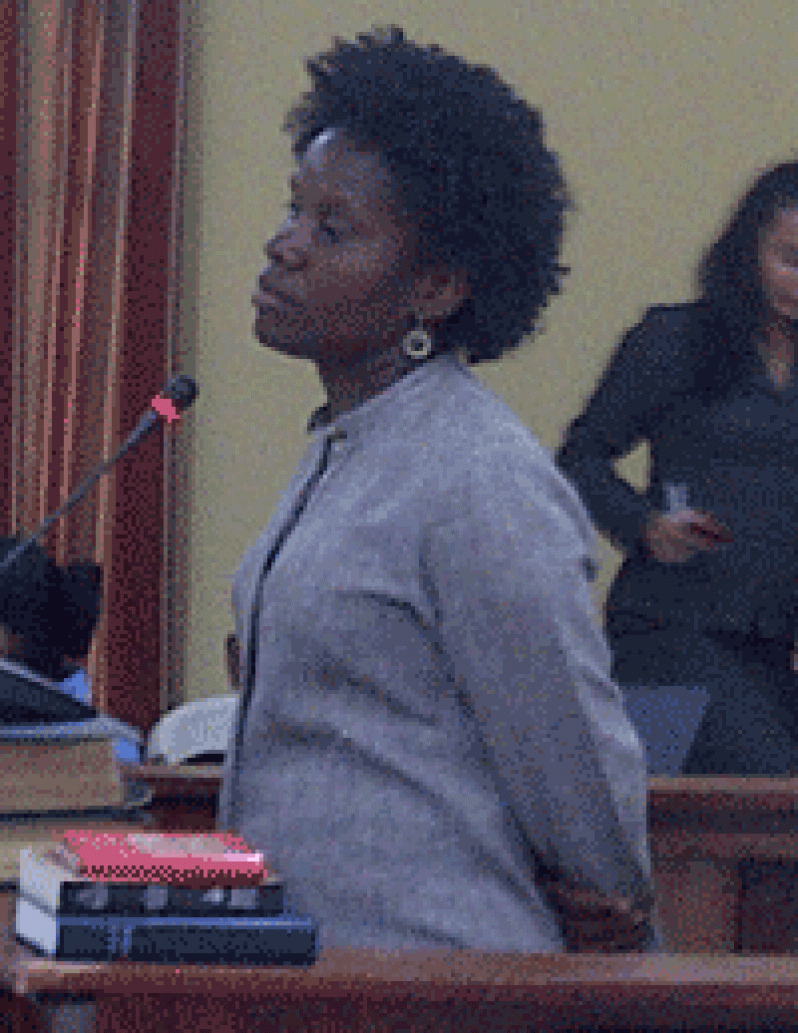APNU MP, Mrs. Vanessa Kissoon admitted to the Commission of Inquiry (CoI), when she took to the witness stand upon its resumption in the Supreme Court Library in Georgetown after a week’s recess, that the protesters were duly wrong to block the Mackenzie Bridge, and that the police were determined to clear the bridge.
 And videographer Vladimir Glasgow failed to show footage of police shooting at the protesters, or to indicate where in his work confirmed the sound of glass breaking as gunshots were fired.
And videographer Vladimir Glasgow failed to show footage of police shooting at the protesters, or to indicate where in his work confirmed the sound of glass breaking as gunshots were fired.
Present at yesterday’s reconvening of the CoI were APNU attorneys, Basil Williams and Llewellyn John; attorneys representing the interests of the 3 deceased, Nigel Hughes and Ms. Hamilton; attorneys for the Guyana Police Force, Peter Hugh and Hukkumchand; attorney for the Joint Services, Keith Massiah; attorneys representing the state, Ganesh Hira and Euclin Gomes; and seeking addition was Ms. Latchmie Rahamat, representing the persons whose proprieties were damaged during the period.
MP Kissoon was first cross-examined by state attorney, Ganesh Hira, who sought details of her activities on July 18, 2012. The Linden regional Member of Parliament, a teachers for 10 years and Parliamentarian for 6 years, outlined her activities, beginning from the time she had left her home in Retrieve, Mackenzie en route to the Kara Kara Call Centre, where she was responsible for setting up the public address system to facilitate persons addressing the marchers when they would have arrived at the designated area.
Asked if she knew the reason for the march on the day in question, Ms Kissoon indicated that it stemmed from a presentation made by Finance Minister, Dr. Ashni Singh announcing increased tarriffs for electricity in the town of Linden, against which the residents called on their leaders and parliamentary representatives to make their position known, because they said they could not then afford to pay the proposed increases, and needed to make this position clear.
Kissoon noted that several past protest actions in the form of marches were peaceful, and that she was a part of the organisation as a selected Member of Parliament to represent the people.
She told the commission that Region 10 Chairman, Sharma Solomon was the person who had applied for permission to hold the protest, and that the march would have been authorized by the police in Linden, having obtained clearance from the Police Commissioner’s Office.
Asked if she knew the details of the permission granted and the guidelines for the march, Kissoon detailed a few of the guidelines and told the commission that she had not seen the permission document for the march.
She was then asked about the police presence at Kara Kara, and she confirmed that there were two male ranks and one female police rank dressed in blue and black standing a way off from the Kara Kara Call Centre, and there were about twenty- plus persons there at that time.
Kissoon told the commission that she got a phone call from her adopted son, indicating to her that there were some elderly women on the bridge who said they needed to rest since they were tired, and it was about 21:30 hrs. or 21:45 hrs.
She noted that she had left the Kara Kara Call Centre and had gone to the bridge, where she was surprised to have seen so many persons, some sitting, as the males were engaged in a game of football. She estimated the gathering to have numbered about 4,000 persons.
She noted that police present at the bridge were ASP Stanton, Sergeant Liverpool and another rank whom she identified as Mr. Whyte, who had been dressed in civilian clothes.
She explained that the protesters indicated to her that they were tired and were resting — something which she noted would have occurred in the past — before moving onto the designated place where the exercise would have concluded.
She indicated that some protesters on the bridge were singing folk songs, and she had even noticed a man playing a guitar while the others were just standing around the approach and eastern sides of the bridge.
She noted that she returned to the Kara Kara area, where she called Regional Chairman, Mr. Sharma Solomon and reported the situation to him.
On return to the Call Centre she said, she noted that the truck with the public address system had already left with the protesters present, so she left the Call Centre and returned to the bridge, where she interacted with the protesters for approximately one hour before she headed to the Wismar shore.
She explained that she had been trying to locate the truck with the public address system, but had not been successful in so doing.
However, she had observed one Mr. Fitz Ralph concluding his presentation to persons on the bridge. Mr. Lincoln Lewis then made his address to the protesters, and she took the opportunity to introduce the next speaker, Mr. Sharma Solomon, who addressed the crowd.
After the Regional Chairman’s presentation, Kissoon said, she left in front of the others and proceeded to the eastern shore, where she met two elderly women who told her that they were tired and wanted to go home. On approaching the eastern side of the bridge, she heard persons shouting and screaming that the police were shooting tear gas. On approaching the end of the bridge, she saw a line of policemen and tear gas being fired to the right side of the road in the vicinity of the Linmine Secretariat compound, where persons had gathered.
She then took the elderly women through the short cut into the Linmine compound, as the police were about 30 feet about from the protesters because persons were all along the roadway towards the bridge, as she took them to safety.
The women were placed into a car where a male already was, having been injured by the tear gas shot at the protesters, and the car took them home.
She returned to the corner of the Washer Pond Road to Casuarina Drive, she said, and began hearing gun shots and seeing the police moving towards the bridge firing their guns.
She said the police had numbered about eight, and were all dressed in dark blue clothes, but a few were clad in khaki. She said she heard persons shouting “Ah man get shoot! Ah man get shoot!”, and she saw a police officer, whom she identified as ASP Stanton, running towards her.
She said that after he had passed her on his way to the police car, as persons said, “That is the policeman that shot the man!”, he turned and fired a shot in her direction before jumping into the said car, which sped away in the Fairs Rust Wootaka direction, as she stood in shock, confused and not knowing what to do besides saying a prayer.
She then saw four young men holding the hands and legs of a young man who was bleeding, and she was assisting in taking the man to the
hospital when the ambulance came up and took him to the hospital. The man died at the hospital.
Kissoon said she was at the hospital and had seen more persons being brought to that institution, having sustained injuries when the police began firing at the protesters on the bridge.
She noted that persons where later identified and the death toll was three persons, as she returned to the area of the bridge after 11:00pm.
Asked why she had given her statement to attorney Nigel Hughes, and if she had mentioned the name of the policeman who fired a shot at her during the protest, she said her statement had been crafted in response to the questions asked by the attorney, and she did not see it as an important issue, since she knew the individual.
The members of the commission then sought other clarification in the testimony she had supplied, and questioned her on the permission obtained for the protest march, and why the bridge had been blocked to vehicular traffic.
Kissoon then indicated that the protesters were duly wrong to block the bridge, and that the police had the right to clear the bridge.
After answering a number of questions from the attorneys for the police and the destroyed properties, she was asked to come down from the witness stand, and Videographer Vladimir Glasgow was called to the witness stand to give evidence on the video footage he recorded on the day in question.
He was questioned by attorney Nigel Hughes, who sought detailed movements of Glasgow on the day in question.
Glasgow told the commission that he was at the bridge from around 08.00hrs, and commenced recording at noon after his colleague had finished using the video equipment.
The footage Glasgow had recorded was shown, and the commission questioned him regarding location and distance from the police at the time of the recording. His answers were given to the best of his ability.
Police attorney Mr. Peter Hugh then asked the videographer to show where there were police shootings in his footage, or any sound of gun shots, but he failed to produce any.
He is expected to return today for the continuation of the cross-examination as the commission resumes its work at 09:30 hrs.



.jpg)









